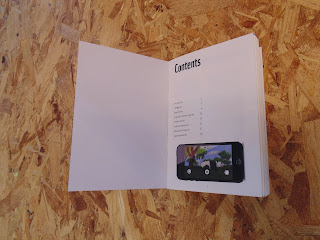I’ve really enjoyed this module, and I put this down to the freedom that came with it. Considering how open the bigger of the two briefs was and the amount of time we were given to spend on it, I don’t see an excuse to not have enjoyed it, as it allowed everyone to focus on something they’re interested in and gave them enough time to be ambitious with it. Their is no comparison between this and the briefs in the other 30 credit module, where one of them was branding (which I don’t really have an interest in), and two were tied to our Summer brief, which didn’t really work out for me because the format of the briefs didn’t suit the research I’d undertaken over Summer. So I’m pleased that I’ve had the freedom that this module has allowed me.
On the assumption and understanding that Extended Practice next year will function in a somewhat similar way to this module, I feel that this module was a good introduction to next year, as it was far more self-directed than any module undertaken up to this point, which I’m pleased about because it shows my time and self management skills in their greatest light.
My Performance In The Module
As it has been throughout the year, my attendance and punctuality has been very good, I can only remember being late to one timetabled session, although I wouldn’t want to be quoted on this.
I also feel that I’ve taken on board the feedback from responsive well since I was given it in late April, which was that my work and my experience as a designer would benefit from experimentation with different new processes. Because of the timing of this, it is shown more in my book cover than in Product, Range, Distribution. The time and effort put into the book cover through the extra processes has somewhat awakened me to the potential stress that can come with being a graphic designer, although this was somewhat minimalised by my good time management. That said, I think that the extra momentum I carried with me in terms of willingness and motivation to go the step further when producing my work has shown in my information boards. Combining the processes of digital printing, laser printing, laminating, and duplexing would probably have been something that I wouldn’t have bothered with at the beginning of the year for an outcome as basic as an information board, and I’d probably have just stuck with the digital mock up and been happy with this.
How This Module Has Helped Me
Because of the enjoyment I’ve found in both the briefs, this module has helped point me in the right direction for COP3, as well as helping me to consider what work I want to focus on in the future.
I found creating the booklet for the app very satisfying in terms of organising something nicely on a page, and this is something I tend to feel often when using InDesign. This isn’t just because I was interested in the brief, because the element in which I engaged with on a personal level was the research and the designing of the app itself.
The slight disappointment I felt with my final book cover has highlighted the importance of experimentation to me, as if I needed to do something involving stenciling or debossing in the future where I was being paid, I wouldn’t want to give a client work I wasn’t happy with. I now realise that learning how to properly execute these processes early is important.
Next Year
Like mentioned above, I know that next year I want InDesign to be pretty central to a fair few of the projects I undertake because I enjoy using it and enjoy working with layout in a wider sense. This is something I identified to some extent in Level 4 as well, through my enjoyment of the layout brief.
I also found that I enjoyed the challenge of making the app consistent with itself, which isn’t really a surprise given how this challenge lends itself to layout. But I noticed that throughout the development stages of the app I felt more comfortable designing an app than I would’ve done a poster. This is very reminiscent of my feelings when working on Beth’s Creative Advertising work in responsive where a print element worked alongside a digital element. I put this down to the intimidation that comes with starting with a big empty space and not wanting to make the first mark. In terms of developing portfolio work next year, I feel like working on app design is something I should pursue next year.
The only field of design that this module hasn’t allowed me to work on is packaging, so I’ve identified this as something I want to experiment with early on next year so I can decide if it’s something I want to persist with going further into Level 6 and even beyond that.























































